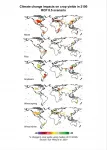(Press-News.org) PULLMAN, Wash. - Most consumers care about the technology and the ingredients used to make their microwavable dinners and other shelf ready meals, according to a new study led by Washington State University researchers. The study found that many consumers are willing to pay a premium for ready-to-eat meals with a 'clean label' showing few ingredients.
They are also more willing to fork out their hard-earned cash when they know their processed foods are made with a new technology that helps limit the number of additives and preservatives commonly found in most ready-to-eat meals.
"Our findings emphasize the importance of providing consumers information about a new food technology and the resulting benefits," said Karina Gallardo, a WSU professor of economics and corresponding author of the study in the journal Agribusiness. "As foods with 'clean labels,' that is foods with few ingredients, become more popular, these types of technologies will also become more valuable to food manufacturers."
For the study, Gallardo, fellow WSU economist Jill McCluskey, and Kara Grant, an economist at Missouri Western University, conducted a survey and choice experiments to estimate how much consumers value foods with clean labels, which typically include only a handful of ingredients and no additives or preservatives. They surveyed another group of study participants on whether or not a clean label that included the name of a new technology used to make their potential purchase affected their valuation.
"Shelf-ready meals that warrant a clean label have been historically difficult to produce with conventional food preservation technology but recent breakthroughs are making it possible," McCluskey said. "However, because consumers are often wary of adopting new technologies, especially when it comes to the food they eat, it is important to consider their perception of the costs and benefits."
The technology the study participants were asked about is called Microwave Assisted Thermal Sterilization or MATS. Developed by WSU food scientist and Regents Professor Juming Tang, MATS works like a microwave oven, using heat to kill pathogenic bacteria, which ensures both food safety and preserves the taste, texture and appearance of processed meals.
"The MATS technology allows companies to sterilize food products in a way that retains their organolepticqualities, making them more similar to a recently prepared meal," McCluskey said.
It also enables using fewer food preservatives and additives compared to current sterilization practices, she added, which makes it possible to have an end product with the difficult-to-achieve clean label.
Overall, 56% of the study respondents who were asked if they preferred foods that bore both a clean label and the name of the new technology exhibited positive reactions.
One of the reasons the researchers think their study participants preferred the new technology is its name.
"It is based on and named after a massively adopted technology, the microwave," McCluskey said. "The fact that the new technology uses the familiar term microwave is likely a factor that increases its acceptance by consumers."
While both groups of participants exhibited an overall preference for clean labels, there was a large minority of people in the study who weren't interested in paying the price premium for the product with fewer ingredients. Around 39% of respondents in the survey group that was asked solely about clean labels and not the new technology exhibited a negative reaction. These participants tended to have lower than a $67,000 annual income, have children in the household and perceived themselves to be less healthy.
"This group does not consider the message 'absence of artificial ingredients' as important in the labels but does consider a gluten free label as being important," Gallardo said. "It really illustrates the fact that the decision of which foods to buy and consume is very complex."
INFORMATION:
This study was supported by the United States Department of Agriculture, National Institute of Food and Agriculture, Agriculture and Food Research Initiative project.
Advancements in wearable technology are reshaping the way we live, work and play, and also how healthcare is delivered and received. Wearables that have weaved their way into everyday life include smart watches and wireless earphones, while in the healthcare setting, common devices include wearable injectors, electrocardiogram (ECG) monitoring patches, listening aids, and more.
A major pain point facing the use of these wearables is the issue of keeping these devices properly and conveniently powered. As the number of wearables one uses increases, the need to charge multiple ...
Neurons, nerve cells in the brain, are central players in brain function. However, a key role for glia, long considered support cells, is emerging. A research group at the University of Basel has now discovered two new types of glial cells in the brain, by unleashing adult stem cells from their quiescent state. These new types of glia may play an important role in brain plasticity and repair.
The brain is malleable well into adulthood. Brain plasticity is not only due to the formation of new nerve connections. Stem cells present in the adult brain also ...
Moreover, they identified a correlation between the progression of the disease and certain corpuscles in the cell nuclei. They published their report in the journal Acta Neuropathological Communications on 13 April 2021.
Aggregates seem to have a function
Affecting over 50 million people, Alzheimer's disease is the most common form of dementia and primarily occurs in people over the age of 65. The pathology of the disease in the brain is mainly characterised by two factors: beta-amyloid plaques outside the nerve cells and tau proteins. The tau protein stabilises tube-like structures (microtubules) inside cells, which are relevant ...
With Oskar Aszmann and his team at the Department of Plastic, Reconstructive and Aesthetic Surgery, MedUni Vienna has long been regarded as a world leader in bionic limb reconstruction. It was only last year that the world's first fully integrated bionic arm prosthesis was developed at MedUni Vienna. This is ready-to-use and is described as "Plug and Play". Although all bionic aids have so far been used in humans, the technique known as osseointegration (direct skeletal attachment) has now been used for the very first time in a bearded vulture - the creature was given a new foot. A paper on this ground-breaking procedure has been published today (Friday) in the prestigious Journal Scientific Reports.
In large birds such as vultures, the loss of limbs results in the ...
Researchers at Tohoku University have demonstrated the designability of novel magnets with magic mirror-like characteristics in organic-inorganic hybrid perovskite (OIHP)-type compounds.
OIHP-type compounds, a type of material used to construct solar cells, possess exceptional optical properties and have recently attracted worldwide interest. Researchers are keen to harness their structural diversity.
Although the superior optical properties of OIHPs have been mainly studied for their photoelectric characteristics, several OIHP-type compounds are known to function as magnets that transmit light. Combining the excellent optical ...
Not only the very concise 11-year cycle, but also all other periodic solar activity fluctuations can be clocked by planetary attractive forces. This is the conclusion drawn by Dr. Frank Stefani and his colleagues from the Institute of Fluid Dynamics at the Helmholtz-Zentrum Dresden-Rossendorf (HZDR) and from the Institute of Continuous Media Mechanics in Perm, Russia. With new model calculations, they are proposing a comprehensive explanation of all important known sun cycles for the first time. They also reveal the longest fluctuations in activity over thousands of years as a chaotic process. ...
On average the earliest memories that people can recall point back to when they were just two-and-a-half years old, a new study suggests.
The findings, published in peer-reviewed journal Memory, pushes back the previous conclusions of the average age of earliest memories by a whole year.
They are presented in a new 21-year study, which followed on from a review of already-existing data.
"When one's earliest memory occurs, it is a moving target rather than being a single static memory," explains childhood amnesia expert and lead author Dr Carole Peterson, from Memorial University of Newfoundland.
"Thus, what many people provide when asked for their earliest memory is not a boundary or watershed beginning, before which there are no memories. Rather, ...
Shifts in weather patterns induced by climate change will increase extreme heat and reduce rainfall across major crop growing regions, with impacts on agricultural production. Will this trigger a decline in the supply of calories needed to sustain the world's growing population?
According to a study published in the Journal of Environmental Economics and Management, global calorie supplies are subject to continuing or even increasing vulnerability to climate change. Climate change could reduce global crop yields by 10% by mid-century and 25% by century's end, under a vigorous warming scenario, if farmers cannot adapt better than they did historically. ...
Every day, around 15 000 children under the age of five die from causes that could have been prevented.
But the children of highly educated parents survive more often than others. This statistic applies worldwide, according to a newly published sweeping systematic review in The Lancet.
The mother's level of education is particularly important for her children's survival.
"One year of extra education for the mother is associated with an approximately three per cent reduction in mortality on average," says Professor Terje Andreas Eikemo at the Norwegian University of Science ...
PROVIDENCE, R.I. [Brown University] -- By adding behavioral components to an infectious disease model, Brown University researchers have developed a new modeling approach that captures the peaks and valleys in new COVID-19 cases seen over the past 16 months.
The approach, published in the journal Scientific Reports, could be useful in forecasting the future trends in the current pandemic, as well as in predicting the course of future ones.
"We know that people's behavior matters in terms of how an infection is spread," said Vikas Srivastava, an assistant professor of ...





